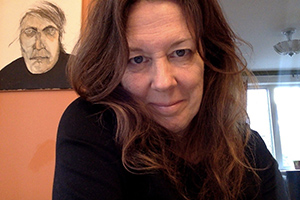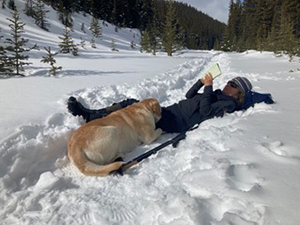Something Unsayable Waiting for its Words: Elizabeth Adilman in Conversation with Sue Goyette

Volunteer Elizabeth Adilman talks with Sue Goyette, whose poem "In which Haraway’s ‘multispecies flourishing’ radiates over the threshold of death to mothers and sisters by way of two endangered wolves on a live cam at this late stage of, well, everything," appears in our spring issue #222. They discuss repetition as a tuning fork, needing time to recharge, and the hybrid form of her essay/poem.
Sue Goyette lives in K’jipuktuk, Halifax, and has published ten books of poetry, a novel, and has edited three anthologies including, most recently, Resistance: Righteous Rage in the Age of #MeToo (University of Regina Press, 2021), Her latest poetry collections are Monoculture (Gaspereau Press, 2022) and A Different Species of Breathing: The Poetry of Sue Goyette, edited by Bart Vautour, (WLU Press, 2023). Her work has been nominated for the Governor General’s Literary Award for Poetry, the 2014 Griffin Poetry Prize and has won several awards including the 2015 Lieutenant Governor of Nova Scotia Masterworks Arts Award. Sue is Halifax's current Poet Laureate and teaches in the Creative Writing Program at Dalhousie University.
The late Steven Heighton in his workbook, Memos and Dispatches on Writing defines poetry as: “The art of calling things by their true and secret name.” And, you have said: “I speak in poetry” in a conversation with translator Georgette Le Blanc about your book, Ocean. What was your hope in writing, “In Which Haraway’s…”? What are you naming?
I’m grateful for Steve’s company in this question. Thank you for bringing his good words to our conversation. I consider this “poetry” I claimed in that quote and your “naming” as verbs, or as ways of being. I wrote “In which Haraway’s…” as a way of recording the cresting and active experience of the days leading up to and following my mother’s dying and the revelation of finding out that she had birthed a daughter before our family who she’d given up for adoption. That was a total shock and, adding to the surprise, was that she’d come to Halifax to give birth all those years ago, a city she had no ties to but chose randomly, and stayed at a nunnery that was literally two blocks from my house and on a street I walk most days. This collision of her earlier self with this specific place and time in such close proximity to me now still astounds me. The work is addressing this half-sister and the more general idea of the complexity of connections and synergy and temporal fluidity.
It was written in the weeks after her death while the days still held the potency of being close and in between her living and then her gone, when those days seemed technicolour and the connections and coincidences were so audacious, they were hard to ignore. I wanted to record the experience by exploring ways to make legible the space when loss feels so actively alert and alive and is everywhere at once while working with the challenge of conveying that movement and emergence in language. I was also aware of including the potentiality of a sister who is out in the world and shares a mother with me. And, on top of all that, I’d been visiting an online live cam of two endangered red wolves every day for months at that point and thought of using the one-sided relationship I was having with them as a way to acquaint myself with this new half-sister out in the world who doesn’t know about me or her other half-sisters. So a lot was going on to start the poem/essay with.
I read Ocean in one (glorious) sitting, rapt by your unusual pairings of phrases, images and thus, metaphor—they truly carried me away. With your most recent piece, “In Which Haraway’s…” there is more a feeling of braiding or weaving in terms of themes that is quite remarkable and educational. I loved reading about complementarity, for example. Your use of concepts like this or motherhood used as metaphor seems to be a strong part of your overall style and voice that I admire. I wonder, can you tell us how you keep track of the various strands as you are crafting your work? Were you surprised by how this project ended up versus when you started it?
You’re drawing such an insightful comparison. Both Ocean and this poem/essay asked me to trust the writing process in a way that I still find both creatively invigorating as well as terrifying. Ocean came by poem while “In Which Haraway…” sustained itself as one long piece so they do indeed move and think differently. I think of the strands you mention more as this poem’s ecosystem or palette or sap whose energy needed to be kept vital somehow and active. Discerning what was portent/important, and here I’m not necessarily thinking thematically but more in terms of the potency unexpected/new meaning offers a poem, and chiming those moments, conjugating them somehow, and thinking with them became the delectable creative challenge. Does that make sense? It felt like an escapade of idea-discovery and then it felt like sculpting and deep and wild play. But most days, honestly, writing this was the only thing that kept me on the ground and in my day. The early days of grief can be so intense and confounding, returning to these six-line stanzas gave me a task and a reason to get out of bed.
Writing in this way, emergently and okay with whatever direction the poem headed in, is motored by surprise because the writing is always leaning into the new and unsaid/unsayable. So yes, I was surprised by how the poem was thinking and knew I needed to trust it and keep clear the space it needed to continue. There was also the surprise of reading it and acclimatizing to the how and what and why of it which is always an immense moment of reckoning and recognizing. I’ve been thinking a lot about how this practice reiterates and is much like the days that break from our plans and asks for the same “going along with” and how any practice that supports being okay with that is a good thing. I’ve also been thinking a lot about how a creative practice moves beyond the making into the being of its practitioner that I’d like to delve in and research.
Your work is richly layered; part creative nonfiction, part prose, part play, all very poetic and original, woven with repetition to strengthen overall meaning and movement. How did you decide on the structure of “In Which Haraway's…”? Did the structure inform the piece or vice versa?
The pace of its sestet felt like its natural gait and once it established itself, I used the set stanza length as a container to work against and to go along with. In this way it offered both constraint and opportunities. It also offered a way for me to mete out the poem in palatable portions. It would be a totally different reading experience, I think, if it were in a block of prose. The line and stanza breaks help aerate its ideas which would be otherwise too thick perhaps and not able to reach into the space/silence the poetic form embodies. This fusion of essay and poem has deepened my intrigue for this hybrid form. I find myself wanting to continue to explore the possibilities of that collusion.
I appreciate that you picked up on the repetition of the piece. Given its length and the recharge that length sometimes needs, I relied on Gertrude Stein’s understanding of repetition as being more of a form of insistence for the idea of the phrase or word rather than a repetition of them. And, in turn, these insistences can become tuning forks for the meaning being developed which is a helpful way of thinking for me when composing a long poem.
What do you think is most important for emerging writers to keep in mind while weaving their work? How do you feel about getting lost?
I believe getting lost is part of the process and is a valuable site: it can occur at the beginning or the starting point of something or at a point when the work is asking to be listened to. Either way, learning to use the discomfort and vulnerability it instigates as a navigational tool and an invitation to listen and then to keep writing until the work finds its footing is part of a creative practice, I think. In other words, those feelings can be considered more as signs that I’m in the company of something unsayable waiting for its words.
I think one of the most important things is remembering that writing is a process of discovery and exploration and transformation that wilts when it’s considered as a way of measuring or testing whether it’s got what it takes or is good enough. Given this late capitalist time, some of us are feeling strong outside pressure on the value of outcome that brings the inherent binaries of good/bad and success/failure which is pesticide for the creative practice and verve. Turning the volume of that thinking down and, instead, valuing the process and practice poems need for the long haul is an important part of our discipline.
I work at paying good attention to how the poem is coming to be, how it’s thinking and what/how it’s exploring and then delving in, using the ecosystem it’s offering to grow the kind of weaving you’re asking about. Being keenly observant while walking outside is one way to study pattern, repetition, the unexpected and how, as Dickinson said, there are no mistakes in them in the natural world.
What are you reading now and whose writing do you return to for inspiration?
To be honest, I’m not reading as much as I usually do right now. I’ve had a tough couple of months and I’m needing more time at windows or the sky and trees than with words. I know from experience that these wordless times mean that my thinking and the language I rely on is being upgraded somehow or recharged, moulting or transforming and so trusting this as an organic part of the process I mentioned above feels easier. When I do return to words, I’ll read widely and anything that catches my eye. I find I’m craving the voice of poets who are thinking about craft and vocation, especially now, in the midst of so much tumult and change, so will head in that direction when I’m ready to.
What writing projects are you currently working on? Could you tell us about them?
I’m hoping to embark into researching more essays similar to “In Which Haraway’s…” I’m really interested in thinking and creating in this hybrid form. I’m deeply interested in learning more about the creative process and how expansively it moves from person to community and the potential the connections it creates offers us after the isolation we’ve endured. I’m also interested in the heft of sentences and how composing with a rigour to each word’s reach and glare can be an enchanting creative experience and so will begin this new project by the sentence, I think, before considering the line.

Elizabeth Adilman
* * * * * * * *









